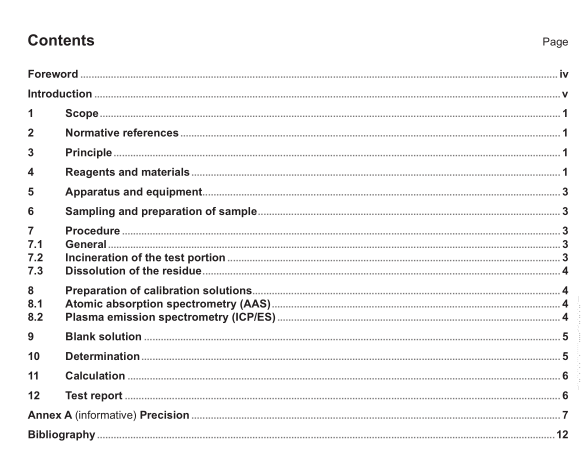ISO 12830 pdf download

ISO 12830 pdf download Paper, board and pulps — Determination of acid-soluble magnesium, calcium, manganese, iron, copper, sodium and potassium
5.2Filter paper, ash free,particle retention 20 um to 25 um.
5.3Crucibles, platinum or fused silica, of minimum capacity 50 ml.
5.4 Muffle furnace, capable of maintaining a temperature of 525°C±25°C.
5.5 Balance, of capacity 100 g, accurate to 0,1 mg.
5.6 Atomic absorption spectrometer (AAS), equipped with airlacetylene and nitrous oxide/acetyleneburners and with hollow cathode lamps for Mg, Ca, Mn, Fe,Cu, Na and K.
NOTE Multi-element lamps can also be used.
5.7 Inductively coupled plasmaloptical emission spectrometer (ICPIOES).
5.8 Disposable protective gloves.
6 Sampling and preparation of sample
lf the analysis is being made to evaluate a lot of paper, board or pulp, the sample shall be selected in accordancewith ISo 186 or lSo 7213, as relevant. If the analysis is made on another type of sample, report the source ofthe sample and, if possible, the sampling procedure.Select the specimens so that they are representative of thesample received.A sufficient amount of sample shall be collected to allow for at least duplicate determinations.Avoid cut edges, punched holes and other parts where metallic contamination may have occurred. Disposableprotective gloves (5.8) shall be worn when handling samples to avoid contamination.
Prepare a test specimen by tearing at least 30 g of small pieces from various parts of the sample.This amountis sufficient for the duplicate determinations described in Clause 7.
Since iron tends to be non-homogeneous in the sample, it is recommended that a composite sample be used.
7 Procedure
7.1General
Although dry ignition followed by acid treatment is described in this International Standard, other dissolutionmethods such as wet ignition or microwave digestion using various acid combinations can also be used,provided that the results have been validated.
WARNING — For samples with high silicon content,microwave digestion with nitric acid will givelower results for magnesium and for some other elements.
7.2lncineration of the test portion
Carry out the procedure in duplicate.
Air-dry the specimen in the laboratory atmosphere until it reaches moisture equilibrium.
Determine the moisture content on a separate air-dried portion, as specified in lSO 638.Weigh this portionat the same time as the test portion used for incineration.For the determination of major elements, includingmagnesium, calcium, sodium and potassium, a 1 g to 2 g test portion (calculated as oven-dry) is recommended.For minor elements, including manganese, iron and copper, test portions of 5 g to 10 g are recommended.Iftrace levels of elements are needed, then use sample sizes that are larger than 10 g.
Carry out ashing of the test portion as described in lSO 1762.
NOTE In order to avoid flames, cover the dish with a lid.The lid should only cover the dish partially to avoid theoccurrence of reducing conditions in the dish, in which case acid-insoluble compounds might be formed. Under reducingconditions, for example, copper might be lost due to the formation of a platinum alloy.
7.3 Dissolution of the residue
After ashing, allow the crucible to cool.To avoid splattering, carefully moisten the residue of ignition with waterand add cautiously, in a fume hood, 5 ml of hydrochloric acid (4.2) to the crucible.Evaporate to dryness on aboiling water bath or hotplate or using an infrared lamp.Repeat this procedure.
NOTE For samples with high carbonate content, more than 10 ml of acid (2 x 5 ml) might be needed.
Add 5 ml of hydrochloric acid (4.2) to the residue. If some insoluble residue is visible, heat, without boiling, thecrucible covered with a watch glass for a few minutes.
Using the filter paper (5.2), filter the content of the crucible into a 100 ml volumetric flask. To ensure that thetransfer is complete, add another portion of 5 ml of hydrochloric acid (4.2) to the crucible and heat again ifnecessary.Filter this last portion of acid into the main portion in the volumetric flask with the aid of some water(5.1). If required for AAS, add 4 ml of lanthanum chloride solution (4.4) or 2 ml of cesium chloride solution(4.5)to the volumetric flask. Fill up to the mark with water and mix.This is the test solution.
8Preparation of calibration solutions
lt is important that the acid concentration and the lanthanum chloridelcesium chloride concentration in thecalibration solutions are the same as in the test solution, since the acid and salt concentration affects theinstrument signal.
Calibration solutions are unstable and should only be prepared on the day they are to be used and stored inplastic bottles.The standard stock solutions are less unstable and can be stored for several months.
Several elements may be combined in the same flask, if desired.
8.1 Atomic absorption spectrometry (AAS)
When atomic absorption spectrometry is used for the analysis,prepare at least three calibration solutionsfor each element in 100 ml volumetric flasks, each containing 10 ml of hydrochloric acid (4.2), by diluting thecorresponding standard stock solutions (4.6). In addition, a blank solution similar to the calibration solutions,but containing no added element,shall be included.









